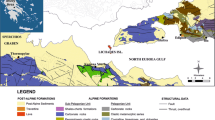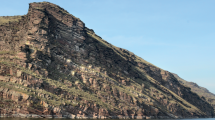Abstract
The transformation of the crystallochemical structure of phyllosilicates (vermiculite and biotite) under the impact of growing cyanobacterial and actinomycetal associations, as well as monocultures of cyanobacteria and actinomycetes, has been studied. The character of the mineral transformation depends on their crystallochemical structure and the type of biota. The most significant changes take place in the contact zone between minerals and microbial associations; the effect of microbial monocultures is smaller. The transformation of biotite proceeds via the stage of ordered mica-vermiculite (smectite) neoformation (rectorite); the destruction of vermiculite has been identified.
Similar content being viewed by others
References
A. P. Afanas’ev, “Weathering Mechanisms of Magnesium-Iron Micas,” in Weathering Crust (Nauka, Moscow, 1973), issue 18, pp. 89–100 [in Russian].
T. V. Aristovskaya, Microbiology of Pedogenesis (Nauka, Leningrad, 1980) [in Russian].
Bacterial Paleontology (Russ. Akad. Nauk, Moscow, 2002) [in Russian].
The X-Ray Identification and Crystal Structures of Clay Minerals, ed. by G. Brown (Mineralogical Soc., London, 1961).
V. I. Vernadsky, Essays in Biogeochemistry (Akad. Nauk SSSR, Moscow, 1940) [in Russian].
V. I. Vernadsky, Essays in Geochemistry, 4th ed. (Moscow, 1934) [in Russian].
G. F. Gauze, T. P. Preobrazhenskaya, M. A. Sveshnikova, et al., Guide to Actinomycetes (Nauka, Moscow, 1983) [in Russian].
B. P. Gradusov, Mixed-Layered Minerals in Soils (Nauka, Moscow, 1976) [in Russian].
L. I. Domracheva, Soil Blossoming and Its Features (Russ. Akad. Nauk, Syktyvkar, 2005) [in Russian].
G. A. Zavarzin, “Role of Microbiota in Rock Formation,” Izv. Sekts. Nauk Zemle, Ross. Akad. Estestv. Nauk, No. 7, 131–137 (2001).
D. G. Zvyagintsev and G. M. Zenova, Ecology of Actinomycetes (Geos, Moscow, 2001) [in Russian].
G. I. Karavaiko, “Microbial Destruction of Silicate Minerals,” in Proceedings of the Vinogradskii Institute of Microbiology: Jubilee Volume to the 60th Anniversary of the Institute, Ed. by V. F. Gal’chenko (Nauka, Moscow, 2004), issue 12 [in Russian].
I. Kostov, Mineralogy: Special Issue (Nauka i Isskusstvo, Sofia, 1957).
E. O. Omarova, Candidate’s Dissertation in Biology (Moscow, 2007).
T. A. Sokolova, T. Ya. Dronova, and I. I. Tolpeshta, Clay Minerals in Soils (Grif, Tula, 2005) [in Russian].
N. N. Sushkina and I. G. Tsyurupa, Microflora and Primary Pedogenesis (Mosk. Gos. Univ., Moscow, 1973) [in Russian].
Structural and Functional Role of Soils and Soil Biota in the Biosphere, Ed. by G. V. Dobrovol’skii (Nauka, Moscow, 2003) [in Russian].
N. P. Chizhikova, G. M. Zenova, A. S. Manucharov, et al., “Changes in the Structure of Clay Minerals under the Influence of Algobacterial Associations,” Pochvovedenie, No. 8, 1012–1015 (2005) [Eur. Soil Sci. 38 (8), 897–900 (2005)].
L. K. Yakhontova and V. P. Zvereva, Basic Mineralogy of Hypergenesis (Dal’nauka, Vladivostok, 2000) [in Russian].
J. F. Banfield and R. J. Hamers, “Processes at Minerals and Surfaces with Relevance to Microorganisms and Prebiotic Synthesis,” in Geomicrobiology. Interactions between Microbes and Minerals, Ed. by J. F. Banfield and K. H. Nealson, Reviews in Mineralogy and Geochemistry, Vol. 35, pp. 163–167 (1997).
W. W. Barker, S. A. Welch, S. Chu, and J. F. Banfield, “Experimental Observations of the Effects of Bacteria on Aluminosilicate Weathering,” Am. Mineral. 83, 1551–1563 (1998).
J. Berthelin, “Microbial Weathering Processes in Natural Environments,” in Physical and Chemical Weathering in Geochemical Cycles, Ed. by A. Lerman and M. Meybeck (Kluwer, Dordrecht, 1986), pp. 33–60.
H. L. Ehrlich, “How Microbes Influence Mineral Growth and Dissolution,” Chem. Geol. 132, 5–9 (1996).
Geomicrobiology: Interactions between Microbes and Minerals, Ed. by J. F. Banfield and K. H. Nealson, Reviews in Mineralogy and Geochemistry, Vol. 35 (1997).
F. K. Hiebert and P. C. Bennett, “Microbial Control of Silicate Weathering in Organic-Rich Ground Water,” Science 253, 278–281 (1992).
K. Jablonovska, I. Styriakova, and P. Javorsky, “Participation of Bacteria in Weathering Processes of Silicates,” Acta Montan. Slovaca 10(Spec.-1), 174–177 (2005).
L. V. Kalakoutskii, G. M. Zenova, V. S. Soina, and A. A. Likhacheva, “Associations of Actinomycetes with Algae,” Actinomycetes 1(2), 27–42 (1990).
P. A. Maurice, M. A. Vierkorn, L. E. Hersman, and J. E. Fulghum, “Dissolution of Well and Poorly Ordered Kaolinites by an Aerobic Bacterium,” Chem. Geol. 180, 81–97 (2001).
I. M. Malinovskaya, L. V. Kosenko, S. K. Votselko, and V. S. Podgorskii, “Role of Bacillus mucilaginosus Polysaccharide in Degradation of Silicate Minerals,” Microbiologiya 59, 70–78 (1990).
E. O. Omarova, G. M. Zenova, N. P. Chizhikova, and V. K. Orleanskiy, “Role of Algobacterial Associations in Soil Forming Process,” in Abstracts of 18th World Congress of Soil Science “Frontiers of Soil Science-Technology and the Information Age,” Philadelphia, USA, 2006 (Philadelphia, 2006), p. 409.
J. R. Rogers, P. C. Bennett, and W. J. Choi, “Feldspars as a Source of Nutrients for Microorganisms,” Am. Mineral. 83, 1532–1540 (1998).
R. Y. Stanier, R. Kunisawa, M. Mandel, and G. Cohen-Bazire, “Purification and Properties of Unicellular Blue-Green Algae (Order Chloroococcales),” Bacteriol. Rev. 35, 171–205 (1971).
W. J. Ullman, D. L. Kirchman, S. A. Welch, and P. Vandevivere, “Laboratory Evidence for Microbially Mediated Silicate Mineral Dissolution in Nature,” Chem. Geol. 132, 11–17 (1996).
P. Vandevivere, S. A. Welch, W. J. Ullman, and D. L. Kirchman, “Enhanced Dissolution of Silicate Minerals by Bacteria at Near-Neutral pH,” Microbial Ecol. 27(3), 241–251 (1994).
S. A. Welch and P. Vandervivere, “Effect of Microbial and Other Naturally Occurring Polymers on Mineral Dissolution,” Geomicrobiol. J. 12, 227–238 (1995).
Author information
Authors and Affiliations
Additional information
Original Russian Text © N.P. Chizhikova, E.O. Omarova, E.S. Lobakova, G.M. Zenova, A.S. Manucharov, 2009, published in Pochvovedenie, 2009, No. 1, pp. 79–85.
Rights and permissions
About this article
Cite this article
Chizhikova, N.P., Omarova, E.O., Lobakova, E.S. et al. Crystallochemical transformation of phyllosilicates under the impact of cyanobacteria and actinomycetes. Eurasian Soil Sc. 42, 69–74 (2009). https://doi.org/10.1134/S1064229309010098
Received:
Published:
Issue Date:
DOI: https://doi.org/10.1134/S1064229309010098




